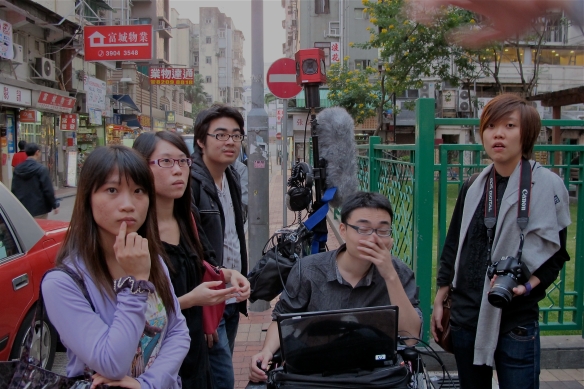 Finally, I got around to trying the Muvi camera. For unknown reasons, it took over two months to arrive from Amsterdam by mail. Too late for my students, unfortunately, who wanted to use it for a ‘bikers diary’ documentary. After the test with the video sunglasses, I was planning to do exactly the same football game – same time, same place – with the Muvi, for easy comparison, but there was just no way I could motivate my son to leave the house today, so we did a game of indoor golf instead.
Finally, I got around to trying the Muvi camera. For unknown reasons, it took over two months to arrive from Amsterdam by mail. Too late for my students, unfortunately, who wanted to use it for a ‘bikers diary’ documentary. After the test with the video sunglasses, I was planning to do exactly the same football game – same time, same place – with the Muvi, for easy comparison, but there was just no way I could motivate my son to leave the house today, so we did a game of indoor golf instead.
In the trial, the Muvi camera is attached to my forehead with a strap that comes in the ‘extreme sports set’ that I ordered with it. I don’t know if ‘indoor golf’ qualifies as ‘extreme sport’, but when I opened the box, I got very excited about the possibilities. It’s a very cool little kit with all kinds of straps and bolts, mainly meant to attach the camera to the handle bar of a (motor)bike. The head strap is supposed to go on your ski helmet – or wherever you like it to go, of course.
Muvi, Trial 1: indoor golf from Bregtje van der Haak on Vimeo.
Depressing results
The results of this test are pretty depressing. The microphone is truly horrible and I can only bear to watch the video if I turn off the audio completely (and I recommend you to do the same). Also, this camera is even worse than the video sunglasses when it comes to movement. It only works well if you keep your head still and look straight ahead of you all the time, which happens to be the case when you’re skiing or biking. I had no idea I was moving my head so much! It’s really scary to see and it makes me feel I should consider yoga or meditation.
The resolution of the Muvi is also less than the video sunglasses (Muvi = 640×480 @ up to 30 fps, using motion JPEG recording to AVI format on a micro SD card of max 8GB) and the camera angle is only 72 degrees, which is not much when you have no viewfinder and cannot see what you’re filming at all. I also did some tests with the camera strapped to my arm. It generated less shaky video, but is totally uninteresting as a viewing angle. Really, the only reason I see to use this camera is to record a very specific point of view from a moving object that is going in one direction. And I would never use he sound.
One inch

The bright side is that it measures only one inch, it costs only 100 Euro (1,000 HK$), and the design is nice. It’s 50 grams of polished black metal, rather than a piece of plastic. The controls are also more user friendly than those of the video sunglasses because, luckily, there’s no MP3 player or photo option. It still takes learning some morse code to understand the language of the lights flashing in different speeds and colors.
In summary, the video sunglasses are a much more interesting addition to the toolkit of a documentary maker than the Muvi. Recording what you see with your own eyes, when you see it, is conceptually very different from a small camera attached to your bike or your forehead. So I only recommend this camera if you like showing off your biking or skiing skills (but only downhill, not slalom).
What’s next?
In a design store, I saw a very small HD video camera with a built in viewfinder, about three times the size of the Muvi. That would mean an enormous improvement of the image, I suppose, but it’s much closer in size to a ‘real’ camera like the FlipHD camera (starting at 200 US$), which has a viewfinder, an optional built in image stabilizer and instant video playback.
And this week, AP Photonics and the Hong Kong Applied Science and Technology Lab (Astri) presented an extremely small optical photo camera (one centimeter), which has a built in image stabilizer and allows you to take sharp photos while riding a horse. Sony, Apple and Ericsson are interested and will start using the new camera in their smart phones this spring. The Hong Kong government invested US$1.6 million into the project and the price of the camera will be: US$1.50 each!
Please note the comment by Jonathan Marks below, who recommends Kodak Zi8, which seems to have it all, including an external microphone.





